St Mary at Hill Monuments


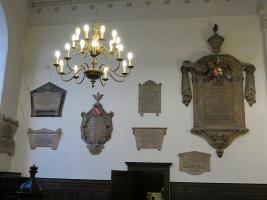

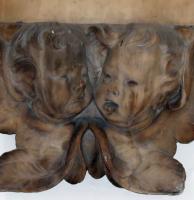
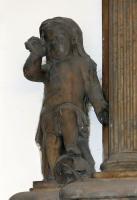
St Mary at Hill Church lies just just east of London Bridge, going along Lower Thames St, then up the little cobbled side
street which is called St Mary at Hill towards Eastcheap; an alternative entrance is from Lovat Lane.
The only indication of the church, with its flat front to the street and tower set back, is the protruding clock;
and far more conspicuous is the tower of St Margaret Pattens framed against the top of the street across Eastcheap.
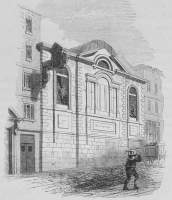 St Mary at Hill, showing the clock.
St Mary at Hill, showing the clock.
St Mary at Hill is a work of Christopher Wren dating from 1676, and he
incorporated part of the walls of the pre-Fire church on the site. The tower was also kept, but replaced later
by the current brick structure by George Gwilt, surveyor for repairs from 1787 - it is not visible from the street,
in the view above, but can be seen from the little churchyard. The significant 19th Century architect James Savage
repaired and restored the Church in the 1820s and again in the 1840s. The mason for the Wren church, who was also a statuary,
was the eminent Joshua Marshall, who carried out work for Wren on a variety of his churches.
We enter through a gate to the little square of what remains of the churchyard, wherein is
the entrance to the church. The yard, the last remnant of the burial ground, was closed in 1846, as noted on a
panel. A few broken monuments are against the church wall, with dates between 1701 and 1880.
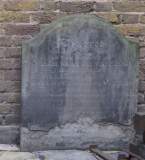
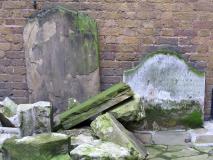 Gravestones in the yard, 19th Century.
Gravestones in the yard, 19th Century.
Inside, the Church is shaped as a Greek cross
inside a square, with Corinthian columns holding up a central dome. Cleared of its pews, it looks somewhat bare, being
effectively a large and largely empty hall, with stacked chairs for use
in meetings, concerts etc, though it does make it easy to admire the architectural
features. The arched ceiling is decorated with a variety of minor stylised flowers and leaf fronds
and light patterning in a Frenchified manner. There is much dark woodwork around the vast altar
which reaches to the ceiling, with carving including the Royal coat of arms with unicorn and lion
above the clock, and panels of carved musical instruments etc. Over one side door is another version
of the coat of arms in darkened wood - it came from the lost church of St George Botolph Lane.
Some plainer panelling up to about 5ft runs around part of the rest of the interior.
Some of the 17th Century woodwork needed replacement in the 19th Century, in a competent,
sympathetic style that is hard to tell from the original the wood carver, W. Gibbs Rogers,
has been much admired for the quality of his work. The glass is mainly plain, with a bit of
modern colour.
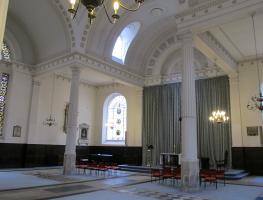
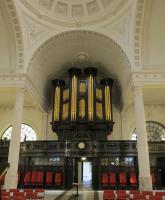 St Mary at Hill Church, interior.
St Mary at Hill Church, interior.
And of primary interest to these pages, we have in the main body of the church and the entrance
lobby a crop of wall monuments, including a bust, a serious cartouche or two, and some more minor
things. Notable monuments, then, in date order from the 17th and 18th Century, and one from the
19th Century, include:
Principal monuments:
- John Woods d.1658, and first wife Anne d.1645, and John Woods,
eldest son by his second wife d. 1670. Woods was a Citizen and Distiller of London,
whose first wife was daughter of a Haberdasher, and the second, daughter of an ironmonger. Dark stone for the inscription,
surrounded by white marble, a custom which was later reversed. The monument has two free-standing Corinthan pillars,
a broken pediment with decorated shield and two particularly vile cherubs sitting on the side portions, and holding wreaths. If
you like cherub sculpture, there is a page on them here.
There are good little 17th Century lions heads under the pillars, and skulls on top of them tucked into the corners of
the pediment. Minor decoration below with floralities, including at the base two festoons, with crossbones and ribbons above
each, and a small cartouche between.
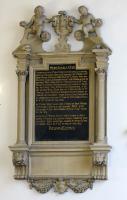
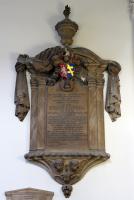
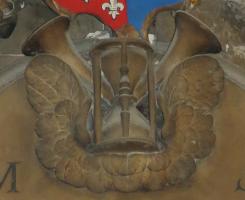
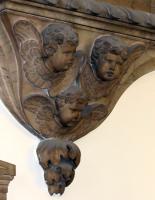
Classical tablets: John Woods, d.1658, and Thomas Davall, d.1700, and details.
- Daniel Wigfall, d. 1698/9, merchant, son of Henry Wigfall of Renishan in the county of Derby.
A well-designed cartouche mounted rather out of reach to get close, solid, with swirls and drapes around, and little
cherub heads in amongst all this. Coat of arms and a knight s visored helmet and droopy leaves above.
- John Harvey, d.1700. The inscription notes he was son of Stephen Harvey by Elizabeth his wife,
daughter of Martin Freman Esq, all ancient inhabitants of this parish and benefactors of the same .
The text is written in fine flowing script with curly tops to the verticals. A cartouche with border scrolling,
winged cherub head underneath, coat of arms on top and little summit flaming urn, somewhat damaged since it was photographed
for the Royal Commission on Historic Monuments in 1929. The monument is signed, by the Irish sculptor William Kidwell,
who made several significant monuments in England, including two in South London, at
Mortlake (Francis Coventrye, d.1699) and at Carshalton
(Henry Herringman, d.1704).
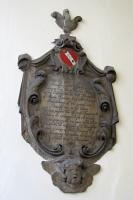
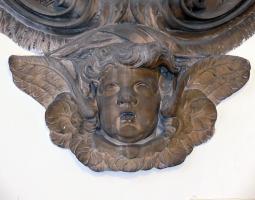
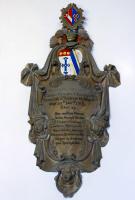
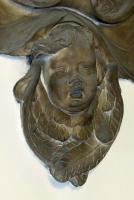
Cartouches, early 18th Century: Harvey and Vickars monuments, and their cherub heads.
- Thomas Davall and wife Anna (Potts), d.1700, Merchant in London.
A large plaque with receding pilasters to the sides, an hourglass, trumpets, coat of arms and foliage, covered in drapes
over the open rounded pediment, which become free-hanging folds on each side, but completely outside and detached
from the main monument, so giving an unusual and distinctive silhouette to the monument. On top is an urn with flame,
and at the base, under a gadrooned (corrugated like a shell) shelf, the curvy apron bears three winged cherub heads
above a terminating leafy bracket. A large and noble monument.
- Henrietta Vickars d.1712/3, with Latin inscription, a fine cartouche with draped surround with
scrolling encompassing cherubic heads, and two coats of arms. Thus the inscription is ona field of roughly violin shape,
with painted arms above, and a smaller painted lozenge of arms above the knight s helm an unusual arrangement.
The drapery is knotted at the sides, falls freely to lie upon the heads of two cherubs, and then downward to the base,
raised up in the centre by a third cherub head. A few small flowers are carved in low relief just below the text.
- Joseph Martyn, d.1718, and his wife Maria, with short Latin script.
Solid monument with curved front, Corinthian fluted pilasters, receding back, open pediment with frond-covered coat of arms,
seemingly broken off and sunk down, and missing a pot or something on top. Dragooned base and brackets, and underneath,
a now-blank coat of arms with little drapes to side and behind, very accomplished. A very decent monument of its type,
and the curved front is unusual.
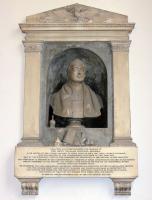
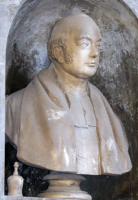
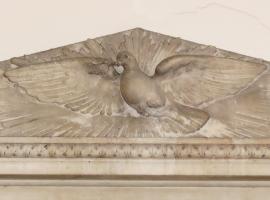
Samuel Nixon's monument to William Johnson Rodber, d.1843.
- William Johnson Rodber, d.1843, rector of the Church. This features a stone bust in a niche,
rather plain of face but carefully made, with underneath a pile of religious bits and bobs and two books, one open, one shut,
scattered to give an informal aspect. There looks to have been a chalice or some such which has been broken
and attached upside down next to the bust. To each side are pilasters, and a pedimental structure of a dove
and sunburst above, rather well done. Samuel Nixon was the sculptor,
and this work seems typical of his style, though I have not seen so much of it. The inscription notes that the monument was
erected by parishioners, and we may note with approval that Rodber was also secretary to the Incorporated Society
for the enlargement and repair of churches and chapels &c.
There are a few other notable monuments in the porch:
- Isaac Millner d.1717, with a long inscription, more of a eulogy, the monument also commemorating a variety
of his offspring, including his son Isaac, d.1743, and his wife, who erected the monument, but later remarried to
become Mrs Ann Colmore, d.1749. An ambitious. tall wall monument, with two pillars,
then a baseless or entirely open pediment to create an attic storey encompassing both the space of the pediment and the
entablature, with shield and billowing decoration, and little knight helm. Above is a pot and two lounging cherubs,
while to the side of the base are two further cherubs, standing, wiping their eyes with handkerchiefs,
each with a foot on a skull. An added section below has the subsidiary inscription and minor decoration including
a further pair of winged cherub heads at the base. The sculptor was Edward Stanton, a prolific statuary who was later mason
to Westminster Abbey, there rebuilding the N front with its carved in the 1820s and 30s.
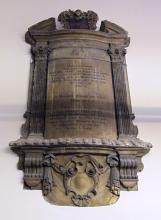
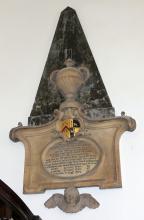
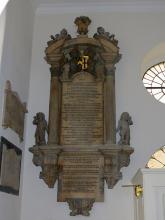
Early 18th Century: Martyn, Smyth and Millner.
- William Smyth d.1726, and 15 of his 16 children, an oval inscription in a shaped rectangular slab with
ogee curved top, coat of arms, large pot above, framed against a dark tall backing in the shape of an obelisk or tall pyramid,
and a single winged cherubic head below. Such obelisk monuments, of which this one is really a rather early example,
had their heyday later in the 18th Century. With their imposing height and ancient Egyptian connotations,
with the associated cult of the afterlife, obelisk monuments formed a taller and less costly alternative to the grander
Classical panels with their rectangular shape and pillars and pediments.
- John Crane of Ireland, d.1823, once of County Down, later Croydon, and wife Elizabeth d.1819
and infant son (see picture at top of page). A large panel with coat of arms and fronds beneath, upturned torches to the sides,
symbolic of the snuffing out of life, and a pediment with wreath and flourishes. Large and quite ornamental.
The inscription notes that many of the charities of this metropolis participated in his bounty, of which the charity schools
of this ward had their share, but the principal part of the ample fortune which he had accumulated by his honest industry,
he divided amongst his poor relations. We may surmise that the executors of his will were among the said poor relations,
as they put up the monument.
Other, plainer monuments:
There are another 16 panels in St Mary at Hill, plus a couple of damaged ones, with little or no sculptural decoration.
After a couple of 18th Century plain memorials, the rest form a group with interest when seen altogether,
as showing some of the popular types of less expensive Classical panels of the first part of the 19th Century.
They form a variety of simple panels, cut with pediments above, some styled like the end of a tomb chest,
and some like a casket tomb seen from the side, and appear either with no backing, or the increasingly popular
white marble panel on a black backing. We note them briefly, in date order again:
Richard Assheton, d.1740, with a brief Latin inscription, on a thinly bordered white marble
with dark streaks, cut with a wavy top.
Timothy Baxter and Ann Baxter, undated but likely end of the 18th Century by its style, or early 19th Century by the font, plain white panel cut with pediment on black shaped backing, with two prominent rivets.
Revd. John Brand, d.1806, Rector for 22 years of St Mary at Hill and St Andrew Hubbard,
and a Fellow and Secretary of the Society of Antiquaries, erected by his aunt Ann Wheatley. Panel with extended shelf above
and below, so that the black backing to the sides forms two receding pilasters, an effect heightened by the small drapes
carved at the top and the supporting feet below with stylised flowers carved upon them.
Between these supports is a curved section of marble the apron on which is a now-blank oval which doubtless
once was painted with a shield of arms, likely those of the Church.

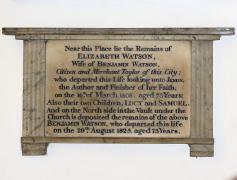
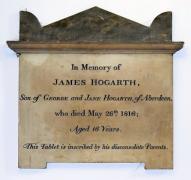
Early 19th Century tomb-chest ends: panels to Brand, Watson and Hogarth.
Elizabeth Watson, d.1808, two children, and her husband, Benjamin Watson, d.1825,
Citizen and Merchant Taylor. With fluted sides and small shelf above and below, and two block supports.
Mrs Elizabeth Megarey, d.1812, and offspring to 1829, and on a separate panel,
another son, her husband Hamilton Megarey, d.1836, and the son s wife Jane Megarey, d.1841.
This is the first of several panels styled as casket tomb ends, with outward sloping sides,
the top being more of a lid than a pediment, though here keeping the ears or acroteria at the sides,
and with little feet. There were too many names for the monument, and the second, lower part, with its own lid
and taking the feet from the original panel, was added underneath, presumably in about 1834.
Mary Ann Riddle, d.1813, and her eponymous child, who died in 1815, just four years old.
Another casket, similar to the Megarey one, and likely by the same stone mason see also the William Hillier panel noted below.
James Hogarth, d.1816, with nice script. A tomb chest end, thus with lid or pediment
above an upper shelf, and cut to have feet below, and vertical sides. Less usually for this date, the upper portion is
in different, darker marble to the once-white panel below.
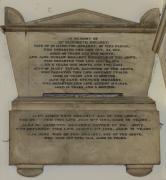
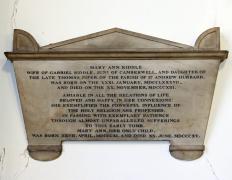
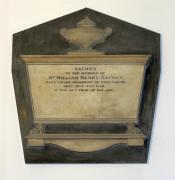
Early 19th Century casket-ends: Megary, Riddle and Savory.
Servington Savery, d.1818, a rector and vicar, with the inscription having a reference to the tomb
itself: Dear reminiscence needs nor bronze, nor stone;// While the heart beat, his tomb is there alone! .
Casket end, without any lid above the upper shelf, but having instead two little carved drapes to the sides,
and small shaped feet.
John Ord, d.1819, son, also John Ord, d.1822, and three infants,
and the wife of the elder Ord (called Mr Deputy Ord ), Catherine Ord, d.1843. Flat panel with
upper curved pediment with no entablature, lightly carved with scrolling, and two brackets below.
Harriett Wilson, d.1829, and her husband s niece, Isabella Stevenson, d.1856,
and the husband, Robert Wilson, d.1869. With upper pediment, and wavy base, and raised central plaque.
William Hillier, d.1833, tomb chest end with upper shelf, lid and side acroteria,
and feet below cut in the same way as for the Megarey and Riddle monuments a score of years previously.
William Old, d.1833, and his wife Mary Old, d.1833.
This and the later tablets are all of the white on black variety. Tomb chest end with upper and lower shelf,
a high relief of a broad, draped pot above in place of lid or pediment, and the feet below carved as stylised leaves,
quite elegantly. There is a shaped black backing, signed by the masons Garland and Field of Camberwell,
among whose other work is a south London example at Battersea, to James Broadhurst, d. 1837.
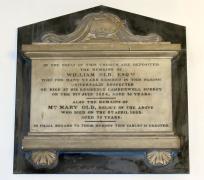
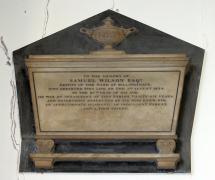
Garland and Field of Camberwell's tablet to William Old, and Samuel Wilson.
Samuel Wilson, d.1834. Another casket tomb, with outward sloping sides, and a flat top,
on which is a nicely carved pot or urn with two handles. The feet, carved with stylised scrolls and leaves,
rest on a separate shelf, which has its own blocky supports, and the whole is on a shaped black backing.
This separate shelf composition is fairly common.
Sarah Phoebe Champnes, d.1837, simply cut tomb chest end with the thinnest of upper shelves,
or lips, and the only carving being on the ears or acroteria. On a rectangular black backing.
This humble piece is signed by the stonemason, M.W. Johnson, whose fairly simple work is found fairly widely across the country.
Jane Dyson Heywood, d.1837, casket tomb in the style of the Samuel Wilson panel,
presumably by the same mason, but with a different and unusually rotund pot or funereal urn on top.
William Henry Savory, d.1842, last of the casket tombs, again similar to the Samuel Wilson panel,
but with carved lion-feet to the casket.
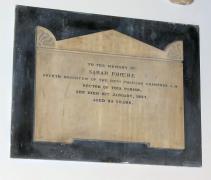 M.W.Johnson's modest tablet to Sarah Champnes.
M.W.Johnson's modest tablet to Sarah Champnes.
Also in the Church:
- Below the Millner Monument in the porch is the remains of some panel showing The Last Judgement
with nude figures rising from graves, and following upwards a figure with a flag, and others perhaps falling downwards.
An angel placed centrally at the base of the composition is sorting out the goodly from the sinners.
Even damaged, the work conveys a sense of urgency and immediacy. A label identifies the work as late 17th Century,
and the author, Dr Roger Bowdler of the conservators, Taylor Pearce studios, suggests that the work may emanate from
the workshop of Joshua Marshall, who you will recall built the Church.
- Several floor slabs, not the interest of these pages, dating from the beginning of the 18th Century.
- The stone font, slender, with octagonal bowl, and gadrooning and minor leafy carving. Winged cherub heads around the wooden font cover. The wood carving on the clock and altar has already been noted.
- Characteristic brass eagle lectern.
- Two ruined monumental panels, of the black on white variety, of vague interest in showing how
such panels are constructed and the parts attached together.

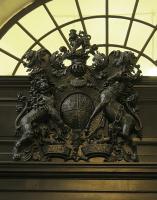

Font, Coat of Arms, and carved wooden panel showing Music.
Outside the Church:
Outside in St Mary at Hill street, we may note that just up the road and opposite, on a wall is an old arch,
decorated with vermiculation, and wide pillars showing rope and floral designs it looks to be one segment from
a line of arches.


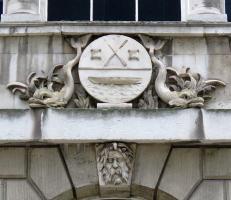
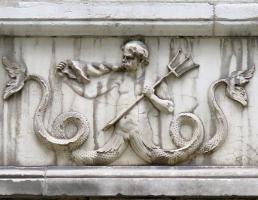
Skull and crossbones entrance to Church, and Watermen and Lightermen building.
Just down the street from the Church is firstly a door with a pediment containing a much painted skull and
crossbones, seemingly wearing a raised visor - this would have been the original entrance to the Churchyard. And near the bottom is a small building housing the Company Of
Watermen and Lightermen, classical work of 1895, one bay wide with arched windows pilasters, and high relief designs of
twin-tailed mermen or tritons, and dolphins, all in a medievalised style. A rather good pedimental bearded head is above
the ground floor window.
http://www.stmary-at-hill.org/history.php
With thanks to the Church authorities for permission to use photos from inside; the Church website is at
http://www.stmary-at-hill.org/history.php.
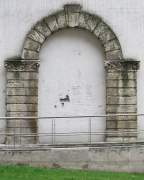 The carved arch.
The carved arch.
Top of page
South and West along Lower Thames St to St Magnus the Martyr
// East to St Dunstan in the East (ruin) // or to All Hallows Barking
City Churches // Christopher Wren // London sculpture // Sculptors // Introduction to church monuments
Angel statues // Cherub sculpture
Home
Visits to this page from 12 Feb 2012: 7,584






 St Mary at Hill, showing the clock.
St Mary at Hill, showing the clock.

 Gravestones in the yard, 19th Century.
Gravestones in the yard, 19th Century.

 St Mary at Hill Church, interior.
St Mary at Hill Church, interior.













 M.W.Johnson's modest tablet to Sarah Champnes.
M.W.Johnson's modest tablet to Sarah Champnes.






